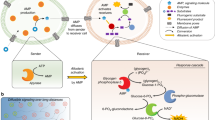Abstract
MANY types of animal cells, in culture and in vivo, form intercellular junctions which are freely permeable to small cellular ions and molecules but not to macromolecules1–10. These junctions are probably the gap junctions seen by electron microscopy11. Cells coupled by such junctions share their metabolites and small control molecules and respond jointly to changing demands on metabolism. Intercellular control of enzymic activity12,13 and metabolic interdependence causing controlled cell proliferation7 have both been observed in mixed cell populations in tissue culture. These integrative effects of junctional communication make a tissue behave as a homogenous unit rather than a collection of different cells.
This is a preview of subscription content, access via your institution
Access options
Subscribe to this journal
Receive 51 print issues and online access
$199.00 per year
only $3.90 per issue
Buy this article
- Purchase on Springer Link
- Instant access to full article PDF
Prices may be subject to local taxes which are calculated during checkout
Similar content being viewed by others
References
Loewenstein, W. R., and Kanno, Y., J. Cell Biol., 22, 565–586 (1964).
Loewenstein, W. R., Ann. N. Y. Acad. Sci., 137, 441–472 (1966).
Potter, D. D., Furshpan, E. J., and Lennox, E. S., Proc. natn. Acad. Sci. U.S.A., 55 328–335 (1966).
Subak-Sharpe, J. H., Bürk, R. R., and Pitts, J. D., Heredity, 21, 342–343 (1966).
Subak-Sharpe, J. H., Bürk, R. R., and Pitts, J. D., J. Cell Sci., 4, 353–367 (1969).
Bürk, R. R., Pitts, J. D., and Subak-Sharpe, J. H., Expl. Cell Res., 53, 297–301 (1968).
Pitts, J. D., in Ciba Foundation Symposium on Growth Control in Cell Cultures (edit. by Wolstenholme, G. E. W., and Knight, J.), 89–105 (Churchill-Livingstone, London, 1971).
Pitts, J. D., in Third Lepetit Colloquium on Cell Interactions (edit. by Silvestri, L. G.), 277–285 (North-Holland, Amsterdam, 1972).
Pitts, J. D., in Developmental Biology of Plants and Animals (edit. by Graham, C. F., and Wareing, E. F.), 96–110 (Blackwell, Oxford, 1976).
Pitts, J. D., and Simms, J. W., Expl. Cell Res. (in the press).
Gilula, N. B., Reeves, O. R., and Steinbach, A., Nature, 235, 262–265 (1972).
Sheridan, J. D., Finbow, M. E., and Pitts, J. D., J. Cell Biol., 67, 396a (1975).
Pitts, J. D., and Finbow, M. E., in InterCellular Communication (edit. by DeMello, W. C.), 61–86 (Plenum, New York, 1976).
McCargow, J., and Pitts, J. D., Biochem. J., 124, 48P (1971).
Azarnia, R., Larsen, W. J., and Loewenstein, W. R., Proc. natn. Acad. Sci. U.S.A., 71, 880–886 (1974).
Coon, H. G., J. Cell Biol., 39, 29a (1968).
Macpherson, I. A., and Stoker, M. G. P., Virology, 16, 147–151 (1962).
Taylor-Papadimitriou, J., et al. Nature, 264, 760–762 (1976).
Author information
Authors and Affiliations
Rights and permissions
About this article
Cite this article
PITTS, J., BURK, R. Specificity of junctional communication between animal cells. Nature 264, 762–764 (1976). https://doi.org/10.1038/264762a0
Received:
Accepted:
Issue Date:
DOI: https://doi.org/10.1038/264762a0
Comments
By submitting a comment you agree to abide by our Terms and Community Guidelines. If you find something abusive or that does not comply with our terms or guidelines please flag it as inappropriate.



